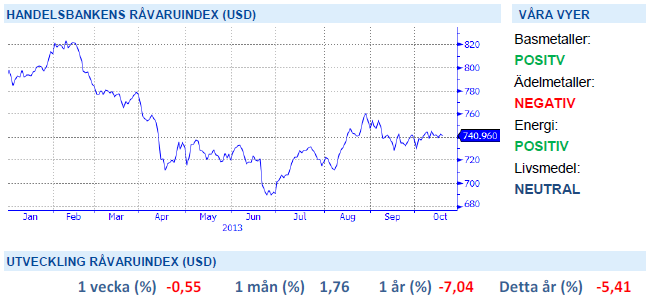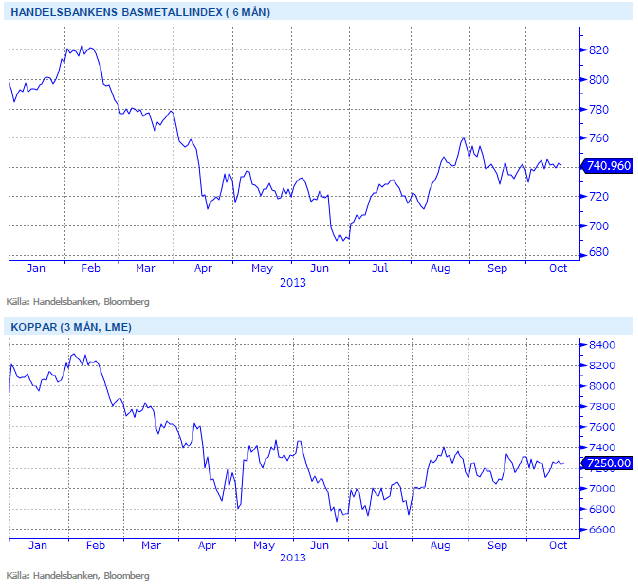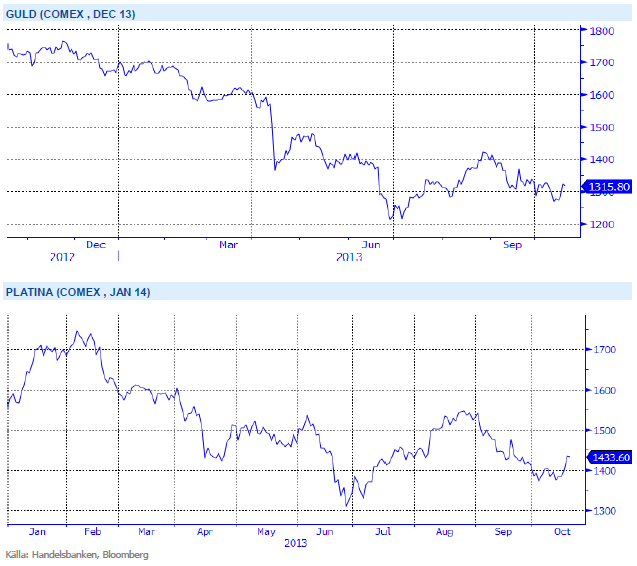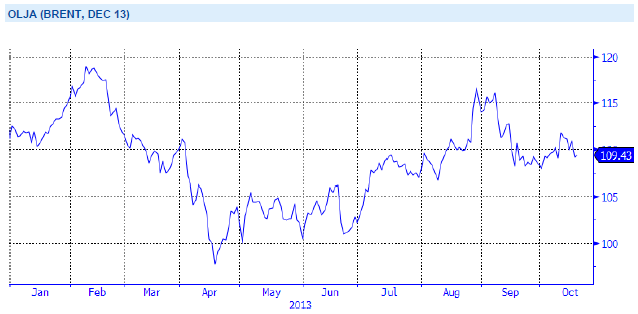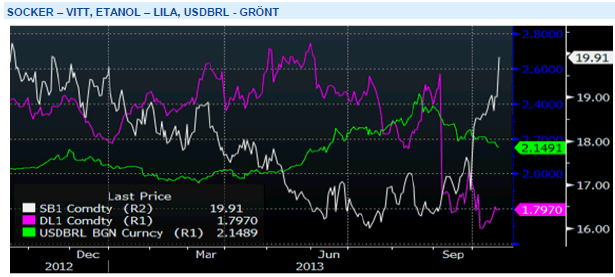Analys
SHB Råvarubrevet 18 oktober 2013
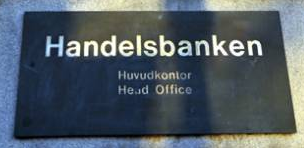
 Råvaror allmänt
Råvaror allmänt
Kinas BNP bekräftar vändning
En hörnpelare i vår tro på stigande råvarumarknad denna höst är att Kinas makro ska stå för höstens positiva överraskning och nattens BNP-siffra är ett tecken på detta, BNP-trenden i Q3 följde det sk Keqiang index uppåt, Keqiang är normaliserat mått på utlåning, järnvägstransporter och elproduktion – en bra indikator på tung industri i Kina. Kinaledningens stormöte i november är nästa större milstolpe i kommunikationen av vad som planeras kommande år. Vi tror att utvecklingen i Kina under H2 och prognoser för 2014 håller uppe kinaberoende råvaror.
Data har annars varit blandad i de stora ekonomierna på sistone. Överlag tror vi att de stora ekonomierna kommer fortsätta stärkas under de kommande månaderna då de erfar positiva efterdyningar från börsuppgångar runt om i världen. Med den akuta skuldtakskrisen i USA bakom oss så tror vi nu att marknaden kan fokusera på andra mer positiva ting. Sedan 2010 har hösten varit en stark säsong för finansiella tillgångar beroende på att det varit tiden då Fed lanserat QE stöd. Årets uteblivna nedskalning av QE är att betrakta som ett stöd och vi ser inget tecken på att höstens styrka ska brytas i år.
Basmetaller
Kina stärker metallerna
Basmetallerna har under veckan till stor del handlats på nyheter kring budgetkrisen i USA. Sedan faran (åtminstone för stunden) har blåst över kryper basmetallerna uppåt. Kinas bättre än väntad BNP-tillväxt för tredje kvartalet stärker metallerna under fredagen, 7,8 % mot väntade 7,5 %, (detta att jämföra mot andra kvartalets 7,5 %). Vi fortsätter att tro att en positiv makromiljö ska stärka basmetaller under hösten. Främst drivet av ett starkare Kina, världens största konsument av metaller.
Aluminium går dock mot trenden och backar 1,5% under veckan på plötsligt stigande lager. LME´s lager för metallen har under veckan stigit med nästan 2 %. Bly är den som sticker ut med en uppgång på över 3 %, medan övriga ligger runt 0,5 %.
Vi tror att Kinas tillväxt kommer överraska positivt under Q4 och Q1, vilket kommer stärka metallerna. Vi tror på: LONG BASMETALLER
Ädelmetaller
Korta positioner driver upp guldet
Torsdagen bjöd på ett kraftigt uppställ av guldet, drivet av att folk köpte tillbaks korta positioner. Rörelsen ser ut tappa kraft här kring 1320 dollar per uns, och vår mer negativa syn på ädelmetaller kvarstår. Under veckan som gått har hela ädelmetallsektorn stigit ganska mycket, och platina visar upp den starkaste uppgången på hela fem procent.
Vi är sedan förra veckan tillbaks i vår mer långsiktiga negativa vy på guldet, framför allt för att de faktorer som borde kunna driva upp priset kortsiktigt nu ebbat ut. När världen nu ser ut att gå in i en period av bättre tillväxt, och med ”flaskhalsar” i tillväxtekonomierna tror vi att det är rätt att favorisera konjunkturdrivna råvaror, och guldets närmast kontracykliska egenskaper kommer då att hämma prisutvecklingen.
Efter en uppgång under sommaren tror vi åter att guldets väg lutar utför. Vi tror på: SHRT GULD H
Energi
Fokus på USA
Oljemarknaden har varit väldigt stilla under veckan där det mesta av fokus riktats mot amerikanska budgetförhandlingar och diskussionerna mellan Iran, USA, Ryssland, Kina, Frankrike, UK och Tyskland där Iran antyder att man är redo att dra ned sin kärntekniska verksamhet för att lätta på de ekonomiska sanktionerna (nästa möte den 7-8 nov i Genève). Amerikansk sysselsättningsstatistik kom in något sämre än väntat och priset backar med 0.7 procent över veckan. Marknaden har fastnat i något av en range som blir snävare och snävare där vi bör se ett trendbrott snart.
Elpriset (Q114) har fallit med ca 2.5 procent under veckan efter att det lågtrycksdominerade vädret ligger kvar. Det blir mycket varmare, mer tillrinning och kärnkraften som föll ut oväntat förra veckan är på väg in igen. Även kol och utsläppsrätterna pressade något ytterligare under veckan. Energibalansen ser ut att förbättras med ca 1TWh från föregående vecka men visar fortsatt på ett underskott om 19 TWh mot normalen. Vi har varit positiva till elpriset sedan i augusti och ser detta som en fullt naturlig korrigering när energiutfallet dessutom ser ut att bli något bättre än väntat, förutsättningarna för ett stigande elpris mot vintern kvarstår dock med underskottet i balansen, marginalkostnadsstödet för kol (svårt att motivera amerikansk export om man ser till transportkostnader på uppemot 20 dollar från gruva till hamn och ytterligare en 10-11 dollar frakt till Europa…) och osäkerheten i kärnkraften.
Energiunderskott tillsammans med osäkerhet kring kärnkraftsverken inför vintern talar för högre elpris. Vi tror på: LONG EL
Livsmedel
Fortsatt blött i delar av Ryssland
Terminspriserna på vete handlas på ungefär samma nivå som för en vecka sedan i både Chicago och Paris. USA:s höstveteregioner faller en del regn, vilket gynnar redan sådd gröda. I Australien fortgår skörden med gott resultat. Argentina är fortfarande torrt och helt klart har vetet tagit skada. Det regnar dock fortfarande i stora delar av Ukraina varför en del ifrågasätter detta, det finns också stora frågetecken angående möjligheten för den sent sådda grödan att utvecklas tillräckligt väl inför vintern. Samma situation, om inte värre, råder i Ryssland där de enligt en del uppgifter haft den mest nederbördsrika septembermånaden sedan år 1885! Även där regnar det fortfarande i en del områden och kanske än mer i Ryssland ifrågasätts chanserna för den sent sådda grödan att utvecklas väl – sen sådd och blöta fält är inte idealiskt. Det finns gott om vete (och annan spannmål) att tillgå i världen, inte minst med en förväntad stor skörd i Australien på ingång – varför en eventuell fortsatt uppgång bör begränsas på kort sikt. Problemen i öst bör dock tas på allvar och följas noggrant då det kan få stora följder för nästa års produktionsnivå.
Kraftig nederbörd i Brasilien, världens topproducent av socker, försenar exporten för säsongen. Det blöta vädret har sen i mitten av juli gett stöd till sockerpriset som noteras upp 25 procent från nivåer kring produktionskostnad och står i nuläget på ett årshögsta. En starkare brasiliansk real mot dollarn är en annan orsak bakom den kraftiga uppgången. Det starka sockerpriset har således drivit med sig etanolen som har vänt upp från treårshögsta.
Försening av skörden efter längre perioder av nederbörd i Brasilien samt en stark brasiliansk real driver upp sockerpriset. Vi tror på: BULL SOCKER
Handelsbankens Råvaruindex
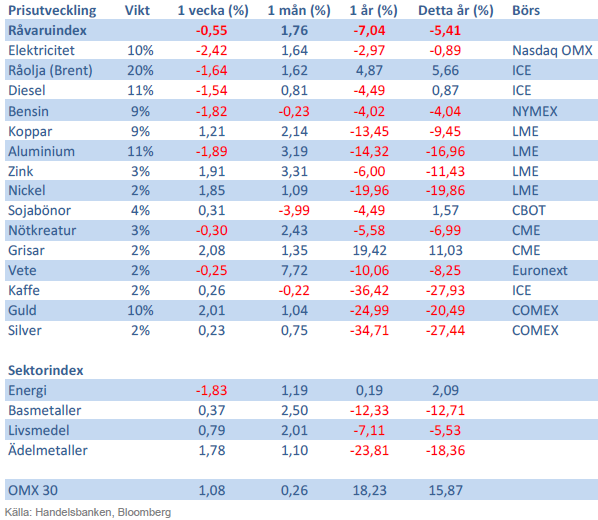
Handelsbankens råvaruindex består av de underliggande indexen för respektive råvara. Vikterna är bestämda till hälften från värdet av nordisk produktion (globala produktionen för sektorindex) och till hälften från likviditeten i terminskontrakten.
[box]SHB Råvarubrevet är producerat av Handelsbanken och publiceras i samarbete och med tillstånd på Råvarumarknaden.se[/box]
Ansvarsbegränsning
Detta material är producerat av Svenska Handelsbanken AB (publ) i fortsättningen kallad Handelsbanken. De som arbetar med innehållet är inte analytiker och materialet är inte oberoende investeringsanalys. Innehållet är uteslutande avsett för kunder i Sverige. Syftet är att ge en allmän information till Handelsbankens kunder och utgör inte ett personligt investeringsråd eller en personlig rekommendation. Informationen ska inte ensamt utgöra underlag för investeringsbeslut. Kunder bör inhämta råd från sina rådgivare och basera sina investeringsbeslut utifrån egen erfarenhet.
Informationen i materialet kan ändras och också avvika från de åsikter som uttrycks i oberoende investeringsanalyser från Handelsbanken. Informationen grundar sig på allmänt tillgänglig information och är hämtad från källor som bedöms som tillförlitliga, men riktigheten kan inte garanteras och informationen kan vara ofullständig eller nedkortad. Ingen del av förslaget får reproduceras eller distribueras till någon annan person utan att Handelsbanken dessförinnan lämnat sitt skriftliga medgivande. Handelsbanken ansvarar inte för att materialet används på ett sätt som strider mot förbudet mot vidarebefordran eller offentliggörs i strid med bankens regler.
Analys
Volatile but going nowhere. Brent crude circles USD 66 as market weighs surplus vs risk

Brent crude is essentially flat on the week, but after a volatile ride. Prices started Monday near USD 65.5/bl, climbed steadily to a mid-week high of USD 67.8/bl on Wednesday evening, before falling sharply – losing about USD 2/bl during Thursday’s session.

Brent is currently trading around USD 65.8/bl, right back where it began. The volatility reflects the market’s ongoing struggle to balance growing surplus risks against persistent geopolitical uncertainty and resilient refined product margins. Thursday’s slide snapped a three-day rally and came largely in response to a string of bearish signals, most notably from the IEA’s updated short-term outlook.
The IEA now projects record global oversupply in 2026, reinforcing concerns flagged earlier by the U.S. EIA, which already sees inventories building this quarter. The forecast comes just days after OPEC+ confirmed it will continue returning idle barrels to the market in October – albeit at a slower pace of +137,000 bl/d. While modest, the move underscores a steady push to reclaim market share and adds to supply-side pressure into year-end.
Thursday’s price drop also followed geopolitical incidences: Israeli airstrikes reportedly targeted Hamas leadership in Doha, while Russian drones crossed into Polish airspace – events that initially sent crude higher as traders covered short positions.
Yet, sentiment remains broadly cautious. Strong refining margins and low inventories at key pricing hubs like Europe continue to support the downside. Chinese stockpiling of discounted Russian barrels and tightness in refined product markets – especially diesel – are also lending support.
On the demand side, the IEA revised up its 2025 global demand growth forecast by 60,000 bl/d to 740,000 bl/d YoY, while leaving 2026 unchanged at 698,000 bl/d. Interestingly, the agency also signaled that its next long-term report could show global oil demand rising through 2050.
Meanwhile, OPEC offered a contrasting view in its latest Monthly Oil Market Report, maintaining expectations for a supply deficit both this year and next, even as its members raise output. The group kept its demand growth estimates for 2025 and 2026 unchanged at 1.29 million bl/d and 1.38 million bl/d, respectively.
We continue to watch whether the bearish supply outlook will outweigh geopolitical risk, and if Brent can continue to find support above USD 65/bl – a level increasingly seen as a soft floor for OPEC+ policy.
Analys
Waiting for the surplus while we worry about Israel and Qatar

Brent crude makes some gains as Israel’s attack on Hamas in Qatar rattles markets. Brent crude spiked to a high of USD 67.38/b yesterday as Israel made a strike on Hamas in Qatar. But it wasn’t able to hold on to that level and only closed up 0.6% in the end at USD 66.39/b. This morning it is starting on the up with a gain of 0.9% at USD 67/b. Still rattled by Israel’s attack on Hamas in Qatar yesterday. Brent is getting some help on the margin this morning with Asian equities higher and copper gaining half a percent. But the dark cloud of surplus ahead is nonetheless hanging over the market with Brent trading two dollar lower than last Tuesday.

Geopolitical risk premiums in oil rarely lasts long unless actual supply disruption kicks in. While Israel’s attack on Hamas in Qatar is shocking, the geopolitical risk lifting crude oil yesterday and this morning is unlikely to last very long as such geopolitical risk premiums usually do not last long unless real disruption kicks in.
US API data yesterday indicated a US crude and product stock build last week of 3.1 mb. The US API last evening released partial US oil inventory data indicating that US crude stocks rose 1.3 mb and middle distillates rose 1.5 mb while gasoline rose 0.3 mb. In total a bit more than 3 mb increase. US crude and product stocks usually rise around 1 mb per week this time of year. So US commercial crude and product stock rose 2 mb over the past week adjusted for the seasonal norm. Official and complete data are due today at 16:30.
A 2 mb/week seasonally adj. US stock build implies a 1 – 1.4 mb/d global surplus if it is persistent. Assume that if the global oil market is running a surplus then some 20% to 30% of that surplus ends up in US commercial inventories. A 2 mb seasonally adjusted inventory build equals 286 kb/d. Divide by 0.2 to 0.3 and we get an implied global surplus of 950 kb/d to 1430 kb/d. A 2 mb/week seasonally adjusted build in US oil inventories is close to noise unless it is a persistent pattern every week.
US IEA STEO oil report: Robust surplus ahead and Brent averaging USD 51/b in 2026. The US EIA yesterday released its monthly STEO oil report. It projected a large and persistent surplus ahead. It estimates a global surplus of 2.2 m/d from September to December this year. A 2.4 mb/d surplus in Q1-26 and an average surplus for 2026 of 1.6 mb/d resulting in an average Brent crude oil price of USD 51/b next year. And that includes an assumption where OPEC crude oil production only averages 27.8 mb/d in 2026 versus 27.0 mb/d in 2024 and 28.6 mb/d in August.
Brent will feel the bear-pressure once US/OECD stocks starts visible build. In the meanwhile the oil market sits waiting for this projected surplus to materialize in US and OECD inventories. Once they visibly starts to build on a consistent basis, then Brent crude will likely quickly lose altitude. And unless some unforeseen supply disruption kicks in, it is bound to happen.
US IEA STEO September report. In total not much different than it was in January
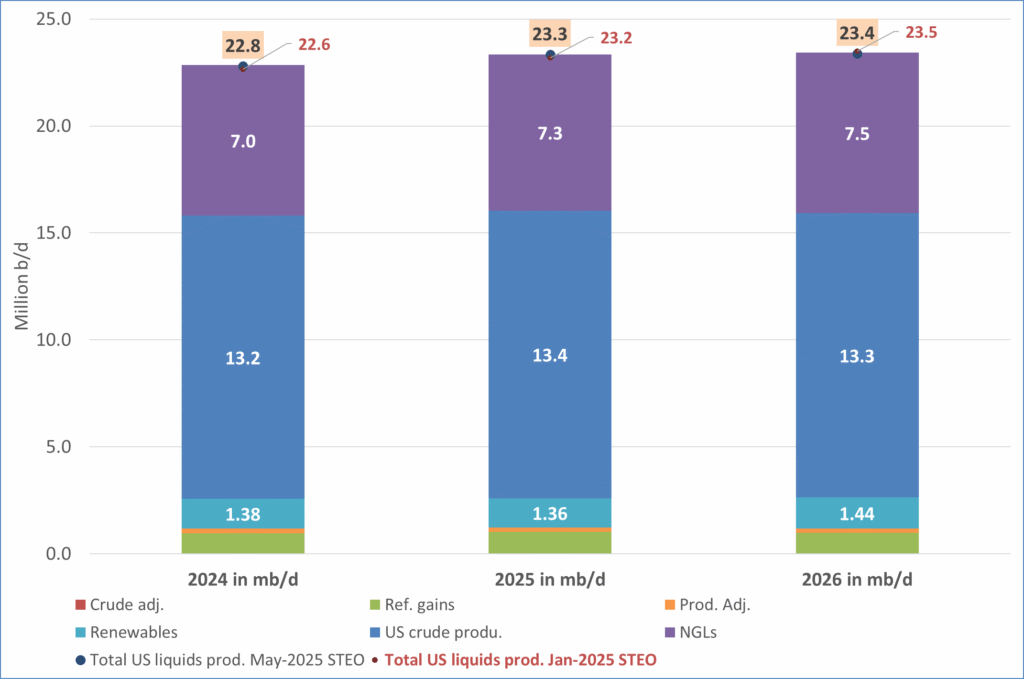
US IEA STEO September report. US crude oil production contracting in 2026, but NGLs still growing. Close to zero net liquids growth in total.

Analys
Brent crude sticks around $66 as OPEC+ begins the ’slow return’

Brent crude touched a low of USD 65.07 per barrel on Friday evening before rebounding sharply by USD 2 to USD 67.04 by mid-day Monday. The rally came despite confirmation from OPEC+ of a measured production increase starting next month. Prices have since eased slightly, down USD 0.6 to around USD 66.50 this morning, as the market evaluates the group’s policy, evolving demand signals, and rising geopolitical tension.

On Sunday, OPEC+ approved a 137,000 barrels-per-day increase in collective output beginning in October – a cautious first step in unwinding the final tranche of 1.66 million barrels per day in voluntary cuts, originally set to remain off the market through end-2026. Further adjustments will depend on ”evolving market conditions.” While the pace is modest – especially relative to prior monthly hikes – the signal is clear: OPEC+ is methodically re-entering the market with a strategic intent to reclaim lost market share, rather than defend high prices.
This shift in tone comes as Saudi Aramco also trimmed its official selling prices for Asian buyers, further reinforcing the group’s tilt toward a volume-over-price strategy. We see this as a clear message: OPEC+ intends to expand market share through steady production increases, and a lower price point – potentially below USD 65/b – may be necessary to stimulate demand and crowd out higher-cost competitors, particularly U.S. shale, where average break-evens remain around WTI USD 50/b.
Despite the policy shift, oil prices have held firm. Brent is still hovering near USD 66.50/b, supported by low U.S. and OECD inventories, where crude and product stocks remain well below seasonal norms, keeping front-month backwardation intact. Also, the low inventory levels at key pricing hubs in Europe and continued stockpiling by Chinese refiners are also lending resilience to prices. Tightness in refined product markets, especially diesel, has further underpinned this.
Geopolitical developments are also injecting a slight risk premium. Over the weekend, Russia launched its most intense air assault on Kyiv since the war began, damaging central government infrastructure. This escalation comes as the EU weighs fresh sanctions on Russian oil trade and financial institutions. Several European leaders are expected in Washington this week to coordinate on Ukraine strategy – and the prospect of tighter restrictions on Russian crude could re-emerge as a price stabilizer.
In Asia, China’s crude oil imports rose to 49.5 million tons in August, up 0.8% YoY. The rise coincides with increased Chinese interest in Russian Urals, offered at a discount during falling Indian demand. Chinese refiners appear to be capitalizing on this arbitrage while avoiding direct exposure to U.S. trade penalties.
Going forward, our attention turns to the data calendar. The EIA’s STEO is due today (Tuesday), followed by the IEA and OPEC monthly oil market reports on Thursday. With a pending supply surplus projected during the fourth quarter and into 2026, markets will dissect these updates for any changes in demand assumptions and non-OPEC supply growth. Stay tuned!
-

 Nyheter4 veckor sedan
Nyheter4 veckor sedanMeta bygger ett AI-datacenter på 5 GW och 2,25 GW gaskraftverk
-
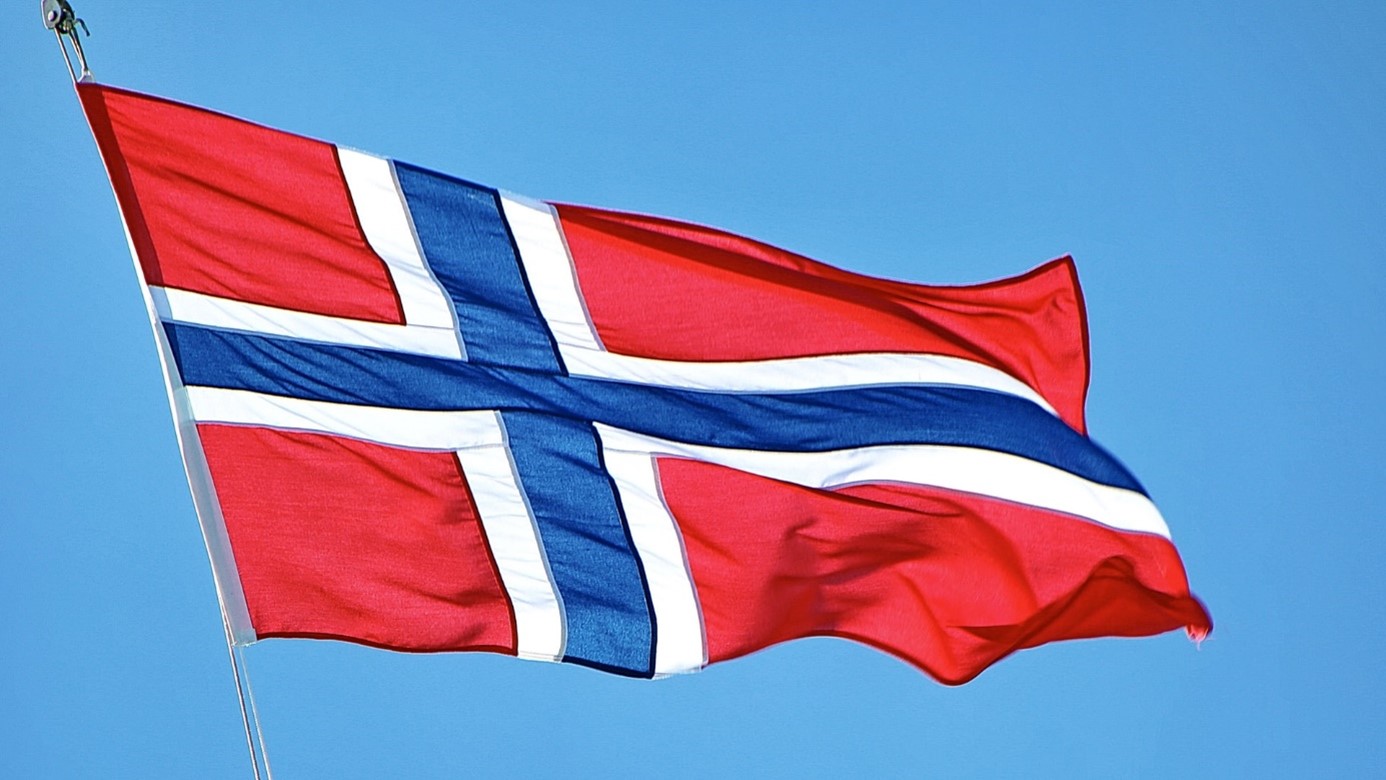
 Nyheter4 veckor sedan
Nyheter4 veckor sedanAker BP gör ett av Norges största oljefynd på ett decennium, stärker resurserna i Yggdrasilområdet
-

 Analys4 veckor sedan
Analys4 veckor sedanBrent sideways on sanctions and peace talks
-

 Nyheter4 veckor sedan
Nyheter4 veckor sedanEtt samtal om koppar, kaffe och spannmål
-

 Nyheter4 veckor sedan
Nyheter4 veckor sedanSommarens torka kan ge högre elpriser i höst
-

 Analys4 veckor sedan
Analys4 veckor sedanBrent edges higher as India–Russia oil trade draws U.S. ire and Powell takes the stage at Jackson Hole
-
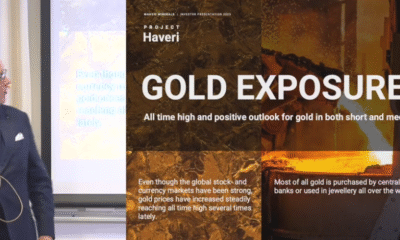
 Nyheter3 veckor sedan
Nyheter3 veckor sedanMahvie Minerals är verksamt i guldrikt område i Finland
-

 Analys3 veckor sedan
Analys3 veckor sedanIncreasing risk that OPEC+ will unwind the last 1.65 mb/d of cuts when they meet on 7 September


